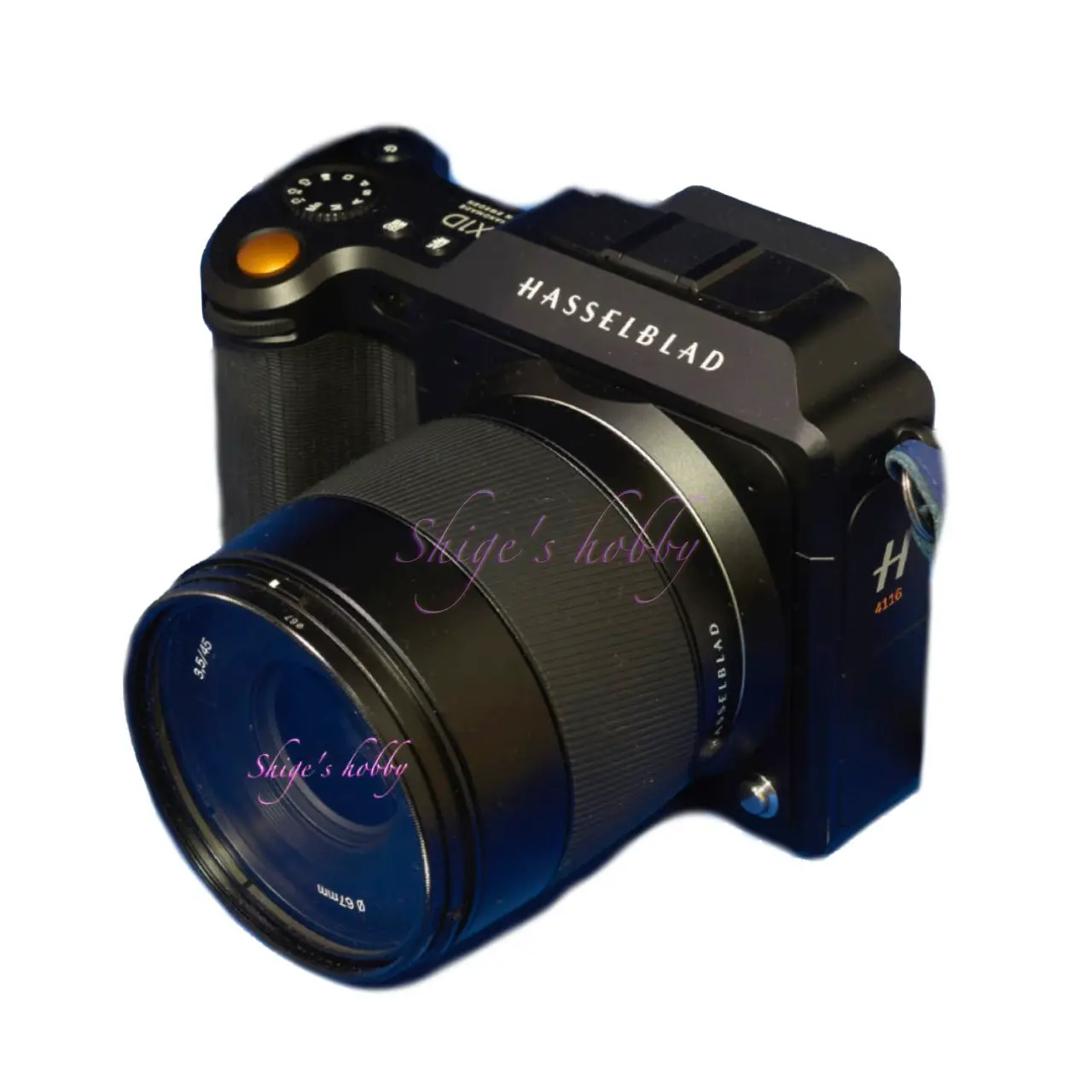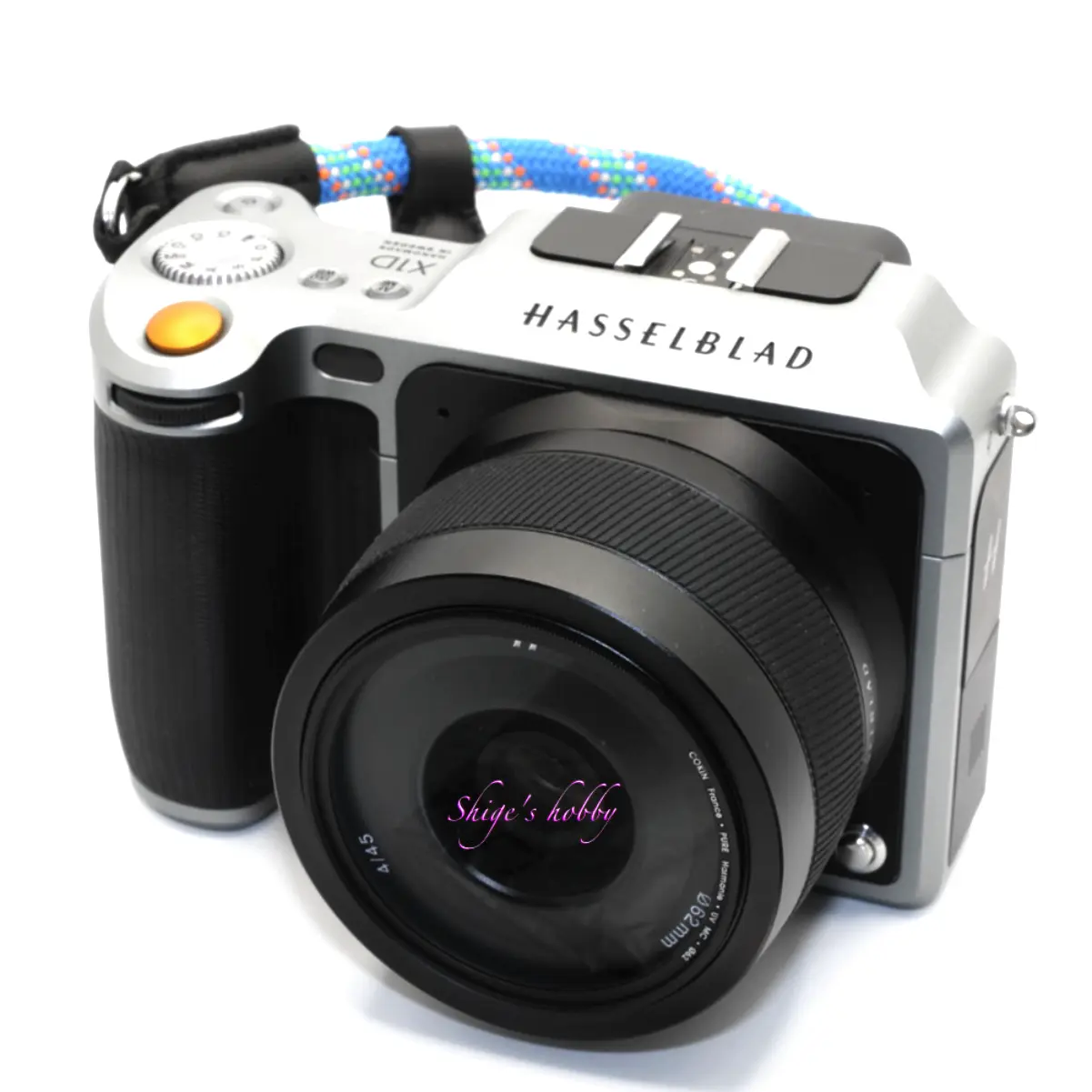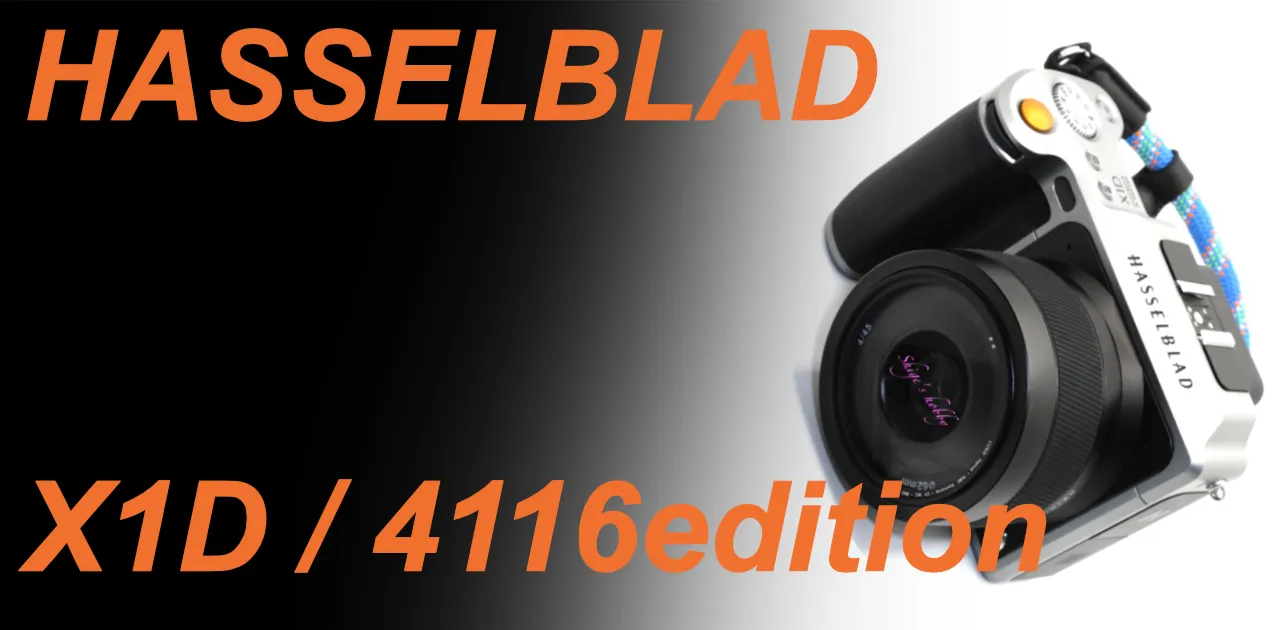Last updated on 2025-05-05
A review and Photo example of the X1D 50C and X1D 50C 4116 edition.
Table of contents
Gallery
Review


1.Overview
The HASSELBLAD X1D-50C / 4116 edition is a mirrorless digital camera equipped with a medium-format digital sensor (44 x 33mm). The original model was released in October 2016, and the 4116 edition was released at the end of January 2017.
The X1D-50C is gray, while the X1D-50C 4116 edition is black, and the only difference between the two is the body color.
Detailed specifications are listed in the table, but the main specifications are as follows.
- Sensor pixel count: 50 megapixels
- Sensor size 44 x 33 mm
- LCD viewfinder / Approximately 2.36 million pixels
- 3.2-inch 920,000 pixel TFT display
- SDXC compatible, dual SD card slot
- Camera has no shutter mechanism
- Sensor shutter available from firmware 1.17.2
- Camera startup time: approx. 5 seconds
2.Usability
The X1D-50C 4116 edition is the first Hasselblad body I’ve purchased. I chose the X1D-50c 4116 edition because the price of the X1D-50c used camera had dropped since the X1DII-50c was released, and I found an XCD 45mm lens and X1D-50c 4116 edition body set for the same price as the X1D-50c body alone. The color of the X1D-50c 4116 edition I got is extremely cool.
What surprised me when I held the camera in my hands was how light and small a camera that doesn’t have a shutter mechanism could be.
Even with the XCD 45 lens that came with the purchase attached, it is smaller and lighter than many mid-range digital SLR cameras.
When the XCD 45P, released later, was attached, it was a camera only slightly larger than the Leica Q, but it could handle a 50MP, 44mm x 33mm sensor, and I realized the evolution of technology and the excellence of the camera concept.
I highly praise the camera’s appearance, but the camera itself has many unfinished parts, and its slow startup time in particular is a fatal weakness in terms of photography opportunities.
After turning off the power, you have to wait about 5 to 6 seconds after pressing the power button before you can start shooting, so it is extremely difficult to capture the moment you want to take a picture.
When using the sleep function with the power on, it seems to use a fair amount of electricity even in sleep mode, and the battery runs out quickly and the body gets hot, so I didn’t feel like using it actively.
It is not suitable for using a compact camera system easily in the field, and I experienced the camera overheating outdoors in hot weather.
The X1D’s fine images are suitable for applications where quick shooting is not required, such as shooting objects on a tripod or still landscapes.
I bought and used the XCD 21mm because the body and one lens were not enough, but I sold it when I got the HCD24mm, the widest lens of the Hasselblad H series lenses.
I sold the XCD45mm that came with the body when I bought the XCD45mmP, and the only XCD lenses I have left are the XCD28mmP and the XCD45mmP, but with these two I have no problems with normal shooting. When I want to change the focal length to the telephoto side, I use a Hasselblad H lens.
I realized that it is better to use the latest version of digital products that are still evolving, so I decided to buy the X2D as soon as it was released.
I feel that the X2D has steadily evolved through three generations. Even so, the camera response is average with the X2D, so it is a slow system in terms of functionality.
XCD lenses are quite expensive, so I use Hasselblad H series lenses, which are reasonably priced.
Since there are no telephoto lenses in the XCD lens lineup, I use Hasselblad H series lenses for telephotos over 200mm.
As for an episode where I used a telephoto lens, I attached an H x1.7 teleconverter to the HC300mm F4.5, the longest focal length of the H series lenses, to try to photograph a hawk at Shirakaba Pass with a lens with a total focal length of 510mm. However, due to a faulty electrical contact between the camera and the lens, the camera would reset when I swung the lens up to photograph the hawk, which was a sad experience for me as it could not be used properly.
After returning to Tokyo from the pass, I asked Hasselblad to investigate the cause of the malfunction, and they said it was a problem with the lens and a faulty electrical contact in the mount of the X1D 4116 edition, so I returned the lens and paid a considerable amount of money to have the camera repaired.
Speaking of focal lengths for the Hasselblad X-series cameras, the sensor size of the X1D is 44mm x 33mm, which is larger than a 35mm full-frame sensor, so the focal length when shooting changes as follows:
- XCD lenses have a focal length that is 0.8 times the focal length of a 35mm lens.
- When a Hasselblad H series lens is attached to a camera using an XH lens adapter, the focal length is 0.8 times the focal length of a 35mm lens.
- When a Hasselblad H series lens is attached to a camera using an XH converter x0.8, the converter expands the focal length of the lens by 0.8 times, and the sensor size magnification factor of 0.8 is added, resulting in a total focal length of 0.64 times, which is almost the focal length of medium format film.
- Since the image circle of Hasselblad HCD lenses is small compared to the medium format film size, vignetting will occur around the edges of the image when shooting with this combination. Phocus will automatically crop the vignetted area. The image outside the vignetting is also saved, so it can be restored with Phocus.
The X1D is a mirrorless camera with a short flange back (the distance from the mount surface, where the lens and body are attached, to the image plane), so a mount adapter can be used to attach a variety of lenses. However, as mentioned above, the camera does not have a mechanical shutter, and lenses that do not have a lens shutter mechanism will use the camera’s sensor shutter to take pictures.
The sensor shutter of the X1D does not have measures to reduce rolling shutter distortion like recent mirrorless cameras, so it is necessary to take measures to prevent subject blur when taking pictures of fast-moving subjects such as trains and animals.
Also, when the camera is processing images, it is important to be careful of shaking of the captured image caused by moving the camera.
This phenomenon is independent of the shutter speed, and moving the camera during image transfer processing will distort the captured image, so care must be taken. Even if you take a picture with a fast shutter speed, you need to take a breath before taking the next picture.

3.Summary
In conclusion, to sum up the X1D-50C /4116 edition, the design was perfected in the first X1D, and the black 4116 edition looks very cool. However, the camera’s low level of completion is difficult to overcome, so it’s best to use it as a camera for taking leisurely landscape photos.
Specification and Series camera
| 項目 | X1D-50C 4116edition | X1DII-50C | X2D-100C |
| Camera Effective Pixels | 50 megapixels 8272 × 6200 Pixels 5.3µm | 50 megapixels 8272 × 6200 Pixels 5.3µm | 100 megapixels 11656 × 8742 Pixels 3.76μm |
| Sensor size | 43.8 × 32.9mm | 43.8 × 32.9mm | 43.8 × 32.9mm |
| Lens mount | Hasselblad X mount | Hasselblad X mount | Hasselblad X mount |
| Image sensor | CMOS | CMOS | BSI type (backside illuminated) CMOS |
| Focus type | CD (contrast) AF | CD (contrast) AF | PD (phase difference) AF & CD (contrast) AF |
| EVF | LCD viewfinder / approx. 2.36 million pixels | Organic EL viewfinder / approx. 3.96 million pixels | LCD viewfinder / approx. 5.76 million pixels |
| Back LCD | 3.2 inch 920,000 pixel TFT display | 3.6 inch 2.36 million pixel TFT display | 3.6 inch 2.36 million pixel TFT display |
| LCD type | fixed | fixed | 2-stage (40°/70°) tilt type |
| Recorded Media | SD card dual slot | SD card dual slot | Built-in 1TB-SSD CFexpress type-B |
| Battery | The included battery is 3200mAh | Rechargeable battery 3400mAh (for X system) | Rechargeable battery 3400mAh (for X system) |
| Size(mm) W x H x D | 148 × 97 × 70 | 148 × 97 × 70 | 148.5 × 106 × 74.5 |
| Weight(g) Only body | 650 | 650 | 790 |
Options
- Hasselblad Rechargeable Battery 3400mAh (for X system)
- Hasselblad BATTERY CHARGING HUB
- XV Lens Adapter
- XH Lens Adapter
- XH Lens Converter 0.8
- Release Cord for X1D Release Cord X
- Tripod Mounting Ring (75mm)
Lens
| Focal length | 35mm equivalent focal length | Lens name | Max aperture | Note | – |
| 20-35mm | 16-28mm | XCD 3,2-4,5/20-35E | 3.2-4.5 | 2024.9.10 | now |
| 21mm | 17mm | XCD21 | 4 | 2018.5.31 | end |
| 25mm | 20mm | XCD25V | 2.5 | 2024.5.7 | now |
| 28mm | 22.4mm | XCD28P | 4 | 2023.9.4 | now |
| 30mm | 24mm | XCD30 | 3.5 | 2017.1.30 | end |
| 35-70mm | 28-56mm | XCD35-70 | 3.5-4.5 | 2020.2.28 | end |
| 38mm | 31mm | XCD38V | 2.5 | 2022.9.9 | now |
| 45mm | 36mm | XCD45 | 3.5 | 2016.12.31 | end |
| 45mm | 36mm | XCD45P | 4 | 2020.1.31 | now |
| 55mm | 44mm | XCD55V | 2.5 | 2022.9.9 | now |
| 65mm | 52mm | XCD65 | 2.8 | 2019.2.1 | end |
| 75mm | 60mm | XCD75P | 3.4 | 2024.11.7 | now |
| 80mm | 64mm | XCD80 | 1.9 | 2019.1.11 | end |
| 90mm | 72mm | XCD90 | 3.2 | 2016.12.31 | end |
| 90mm | 72mm | XCD90V | 2.5 | 2023.12.21 | now |
| 120mm | 96mm | XCD120 macro | 3.5 | 2017.12.10 | end |
| 135mm | 108mm | XCD135 | 2.8 | 2019.3.24 | end |
| 230mm | 184mm | XCD135 x1.7 | 4.5 | 2019.2.27 | now |
Reference link
- Hasselblad X1D-50C new product review by Digital Camera-Watch
- HASSELBLAD X2D Official Web-site
- HASSELBLAD X1DII Official Web-site
Update history
- 2025.3.16
- 2024.03.05
- 2024.02.13
- 2022.09.03
Affiliate Link
- Some external links are advertisements and clicking them may generate income for the site administrator.
- Hasselblad Lenses・Ads by Amazon
- Hasselblad books・Ads by Amazon

Amazon Prime Sale



Be First to Comment